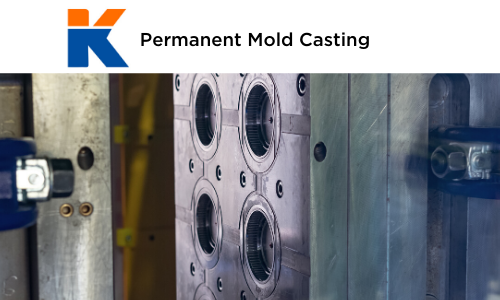Is Permanent Mold Casting the Solution To Your Casting Needs?
When determining the best casting method for your project, permanent mold casting should be a consideration. Permanent mold casting is a process for producing a large number of precise, accurate castings using reusable molds.
The casting process involves pouring molten metal into a mold where it will sit until it cools and solidifies. The mold will then be opened and the casting removed, leaving the mold to be reused again and again. Mold making involves a high-temperature metallic material, such as cast iron or hot work die steel, which can withstand the repeated heating and cooling involved with large volume production.
Manufacturers are often faced with deciding between permanent mold casting and sand casting.
Permanent Mold Casting vs. Sand Casting
The permanent mold casting process is a molding procedure that combines gravity-induced pressure with rapid solidification to produce fully functional castings that can be used for large volumes of production. Permanent mold casting produces metal with superior surface finish, better dimensional tolerance, and more uniform mechanical properties when compared with metal solidified using the sand casting process.
Permanent mold casting is considered to be a non-expendable type of mold casting.
Sand casting is one of the oldest, simplest and popular types of casting. Sand casting is a cast part produced by shaping a mold from a sand mixture and pouring molten liquid metal into the cavity in the mold. The mold is then cooled until the metal has solidified. Sand casting allows for very small batches to be made compared to permanent mold casting and at a reasonable cost.
Sand casting is considered to be expendable mold casting.
So the major differences are that permanent mold casting is better for larger projects and is non-expendable whereas sand casting is more beneficial for small batch production despite it being an expendable casting process.
Common Materials Used in Permanent Mold Casting and Sand Casting
Common casting metals for permanent mold casting are:
- Aluminum alloys
- Magnesium alloys
- Copper alloys
Because of its ability to cast materials with high melting temperatures, common casting metals for sand casting are:
- Aluminum alloys
- Brass alloys
- Cast iron
- Cast steel
Advantages of Permanent Mold Casting over Sand Casting
Some of the advantages of using the permanent mold casting process over the sand casting method are:
- Reusable mold
- Good surface finish
- Better level of dimensional accuracy
- Ability to produce complex shapes and designs
- Better mechanical properties which include the strength of the casting
- Casting production is competitively priced
- A finer grain structure
- It increases the repeatability of casting
- High volume production runs
- Able to achieve a higher as-cast surface finish over the sand casting process
- Precise and consistent control over dimensional attributes
- Improved definition and detail within parts
- High quality of surface finish on as-cast products
- Ability to design thinner wall thicknesses
There are many advantages to the permanent mold casting method, but no matter which method you decide to use, KICastings can help you determine the method that will be most beneficial for your product – and your budget. We are able to offer solutions to complex problems thanks to our years of accumulated experience in R&D design and precision parts manufacturing. Contact us today for a quote. Check out our photo gallery for examples of products made with permanent mold casting.


